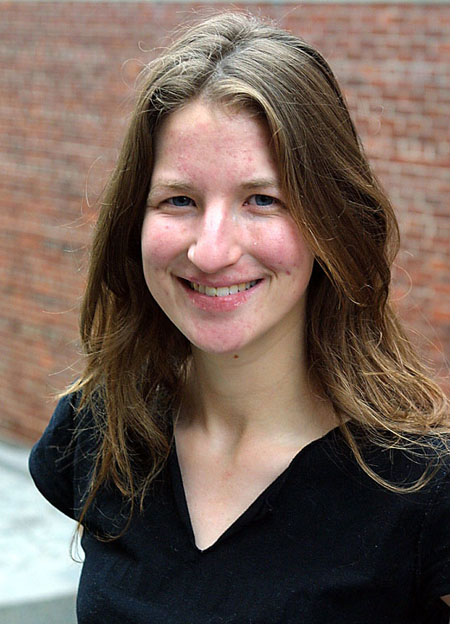Distributed May 26, 2003
For Immediate Release
News Service Contact: Kristen Cole
Martha Lackritz
Senior oration: “Archiving Immortality”
Martha Lackritz of San Antonio, Texas, delivered an oration titled “Archiving Immortality” during Brown’s 235th Commencement. Lackritz addressed her classmates on Monday, May 26, 2003, at 10:30 a.m. in the Meeting House of the First Baptist Church in America. The text of her address follows here. [Return to release 02-132]
 Good morning everyone, and congratulations to the class of
2003.
Good morning everyone, and congratulations to the class of
2003.
Here it is. Your diploma: Your name inscribed in the book of education – a stamp on your resume that says, “Give this one a chance.” Though perhaps graduation is more about being remembered – being a part of something, something that existed long before us, and will last long after we are gone. Perhaps we are one step closer to immortality.
This is a theme not unfamiliar to humankind. In Roman mythology, the goddess Aurora granted eternal life to her lover, Tithonus, who unwisely neglected to specify eternal youth. As a result, he grew older and feebler until he begged to be allowed to die, at which point he was transformed into a grasshopper.
Woody Allen, when asked whether he was trying to achieve immortality through his films, replied he would rather achieve immortality by not dying.
I say, forget about immortality: Tomorrow is as long and as brimming with possibilities as all the days of your life.
This year, I visited the new Texas Modern Art Museum – a glorious glass construction that appears to float over a shallow pool of water. On the second floor was the piece that struck me the most. It was Anselm Kiefer’s Book with Wings – an enormous book propped on a stand, with wings extending from the pages at least three times the length of my own arm span. The irony was in the fact that the piece was made entirely of lead – an unlikely material for flying.
Having grown up with a father whose collection of rare books filled the entire second floor of his house, this frozen image of the book, in an era where the screen is slowly replacing the page, continues to resonate in my life today. At Brown, I sought familiar territory among the yellowed and delicate texts of the John Hay Library, where I took a job working for the University archivist, Martha Mitchell.
If Brown were a brain, Mrs. Mitchell would single-handedly represent the cerebral cortex: that resilient, outer gray matter devoted to long-term memory. Having started at Brown in 1949, she has become its most faithful employee, and the author of the Encyclopedia Brunonia.
My first day on the job, I found her in her office. Before me was a very small, gray-haired woman behind a desk scattered with papers and a floor tiled with boxes. It was a mess. But it was my kind of mess: 19th-century correspondence with script that sprawled illegibly across the pages, photographs of former football stars who stood sepia-colored with arms poised to throw the ball, crisp newspaper clippings from the Civil War, and even Horace Mann’s rocking chair.
I thought to myself, this woman is the past incarnate – she is a walking library, a human book with feet the size of small birds.
Ask her to tell you about the former deans of Pembroke College, and she will give you a genealogy of names and scandals that web invisibly across the campus’ history. Ask her to tell you whether the mythical Professor Josiah Carberry is still alive, and she will likely respond, “Why, he’s as alive as he’s ever been!”
Here in the archives, our most beloved and most celebrated academic – Professor Carberry, lone member of the department of “psychoceramics” – lives on mysteriously. Although the professor was born in a prank in 1927, Martha has assured that Carberry remains the most present professor never to be present.
Ask her about the Brown alum of 1856 who was arrested for “sending obscenities through the mail,” and to this she’ll sigh, “Oh, Ezra ... Ezra Haywood. Would you like to know what he looked like? Because I have his death mask.” Surely, eager to know what exactly a death mask is, you will follow her as she descends gleefully into the library stacks, her tiny feet marching through the labyrinth of shelves, until she reveals a head-sized box with the words Ezra Haywood, death mask written across the top.
“What do you think of this?” she’ll say, lifting the sides of the box. What will then be slowly and horrifically revealed is a lifelike plaster mask of the deceased, sleeping undisturbed amidst the pandemonium of archived objects.
The death mask wants to achieve exactly its contrary: It freezes an image of life long beyond death. Yet it is silent. It speaks neither for the past nor the future.
Like Providence mystery writer, H.P. Lovecraft, who once lived in a home directly behind the John Hay Library, Martha is a storyteller. One could even say that they have both desired to revive things: The archivist resuscitates the long-forgotten, while the writer of gothic tales brings back the terrors of the grave. In one story,[1] Lovecraft writes of a doctor who experiments on dead bodies with the hope of resurrecting them. Martha is such a doctor, whose patients’ lives endure across the scattered pages and memorabilia that constitute the archives.
This year, Mrs. Mitchell is retiring. With her retires an endless archive of anecdotes about Brown that only she has kept alive through half a century in the John Hay Library. Working in the archives with Martha has done far more than simply familiarize me with my University’s history: It has taught me the very significance of preservation – the ongoing history that we add to everyday – our daily chance to change it, to pull forward the past and remake the future in the mold of our ideals.
Meanwhile, immortality keeps going – in a way. Lives are remembered, as are deeds, words, conflicts, resolutions. Without memory, we are nothing – hollow masks of inexperience: mortals.
Here is where you and I come in. Our books have given us wings, but wings of lead. That is to say: It is up to us to take flight, to draw from the annals of history and give it wings of feathers. This is immortality.
According to Martha, in the old days, Commencement addresses were recited in Latin. Only the student audience members were given translations, on which were written the cues for laughter or assent that proved the commendable classical education of Brown’s students. Nowadays, you have been given the fortune to be “in” on what we’re saying. Nonetheless, as an homage to those days, I should like to end in somewhat similar histrionics.
As Roman orator, Caius Marcus, once wrote: “[no] parent wished for his children that they might live forever, but rather that they might act in life with virtue and honor. I would add more, my fellow citizens, if words could give courage to the faint-hearted; to the brave I think that I have said enough.”
Thank you.
######





